Saturday – Leominster – At dawn the eastern sky is a blushing pink-orange. There is a frost. Later the sun shines brightly as I set off to the Millennium Orchard for some work on the apple trees. The two I work on have a good many crossing branches and these need to be thinned out. Some are simply too thick for my pruner and someone with a ladder will need to saw them. Russell and I then set about trying to remove the heavy guards around the trees. Most of the trees are bending over slightly and rubbing against the guards. It is very hard work as the nuts and bolts holding the two halves of the guards are rusted. We get a couple apart and removed but two more are left. They have been sprayed with WD40 and we need better spanners to remove them.
Sunday – Leominster – The sky is completely cloudless and the sun, still low in the southern sky, lights up the roofs of the buildings opposite. There is a light frost. A Blackbird sings in the street trees. A Wood Pigeon coos, Blue Tits chatter and Jackdaws chack. Over the railway and onto Butts Bridge. The River Lugg looks unchanged from last week. A Common Buzzard flies up from Easters Meadow. Chaffinches, a Song Thrush and Blackbirds sing and a Great Tit and Great Spotted Woodpecker call.
These days we are all implored to cut our carbon footprints yet overhead the message has not got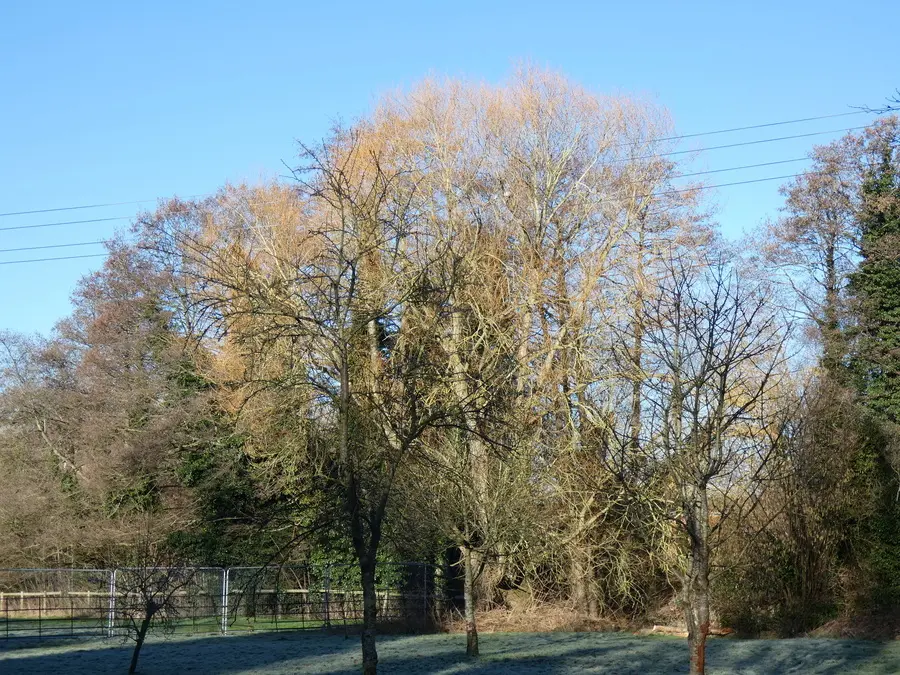 through, vapour trails in every direction, London to Dallas, New York to Istanbul, Boston to Zurich. Into the Millennium Park. Snowdrops are going over, cowed by the frost. Blue Tits chatter, Magpies mutter, a Carrion Crow caws and a Robin sings in the trees. A few daffodils have come into flower. The Minster bells toll the hour but for some reason the call to morning prayer does not follow. A tent has appeared between the Peace Garden and the railway. The River Kenwater also remains unchanged from last week. A rabbit bounds across the lawn opposite. Another runs around the back of the youth hostel. I take a picture of a tree by the river glowing in the sun with the Victoria plum in front of it. Unfortunately I feel that the electricity wires crossing in front of it do not help the composition, although a dog walker thinks maybe it is a complementary picture of nature and modernity.
through, vapour trails in every direction, London to Dallas, New York to Istanbul, Boston to Zurich. Into the Millennium Park. Snowdrops are going over, cowed by the frost. Blue Tits chatter, Magpies mutter, a Carrion Crow caws and a Robin sings in the trees. A few daffodils have come into flower. The Minster bells toll the hour but for some reason the call to morning prayer does not follow. A tent has appeared between the Peace Garden and the railway. The River Kenwater also remains unchanged from last week. A rabbit bounds across the lawn opposite. Another runs around the back of the youth hostel. I take a picture of a tree by the river glowing in the sun with the Victoria plum in front of it. Unfortunately I feel that the electricity wires crossing in front of it do not help the composition, although a dog walker thinks maybe it is a complementary picture of nature and modernity.
Into the churchyard. There are far fewer Blackbirds around now as the continental winter migrants have returned home. Fresh molehills have been thrown up.
Friday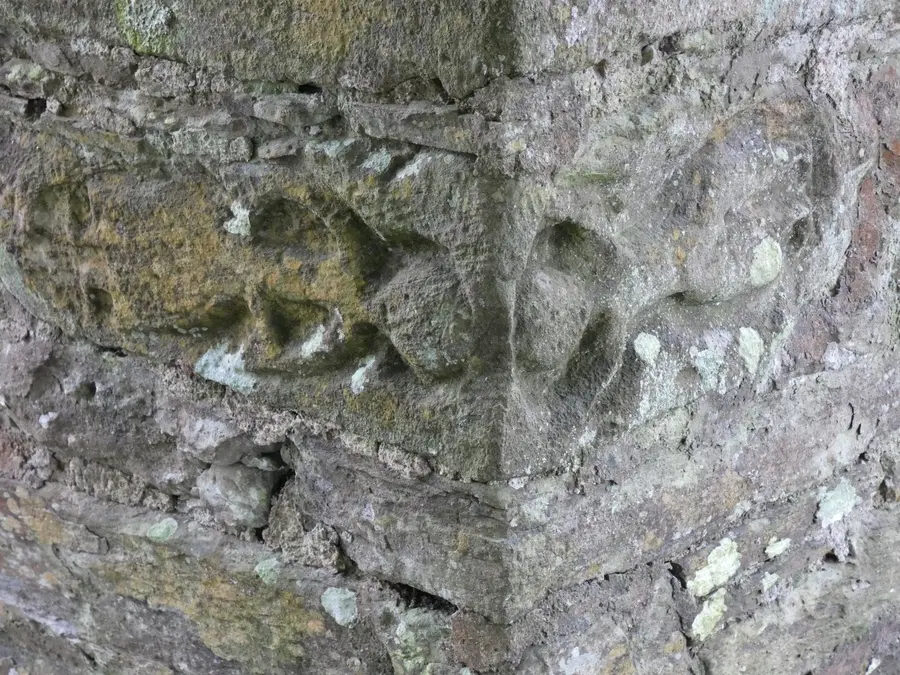 – Bryngwyn – A small village between Painscastle and Gladestry. I park on the edge of the Bryngwyn and Newchurch Common, also called Bryngwyn Hill. A relatively modern sign of various admonitions is signed “The Lord of the Manor”. Ravens bark in the distance. Gorse is in flower, as it is every month of the year. I walk back to the little village. The Victorian Rectory is, of course, a very substantial house. The coach house had three arched entrances for coaches. Across the junction is High Park, a strange building; a stone house with a wood clad extension containing
– Bryngwyn – A small village between Painscastle and Gladestry. I park on the edge of the Bryngwyn and Newchurch Common, also called Bryngwyn Hill. A relatively modern sign of various admonitions is signed “The Lord of the Manor”. Ravens bark in the distance. Gorse is in flower, as it is every month of the year. I walk back to the little village. The Victorian Rectory is, of course, a very substantial house. The coach house had three arched entrances for coaches. Across the junction is High Park, a strange building; a stone house with a wood clad extension containing 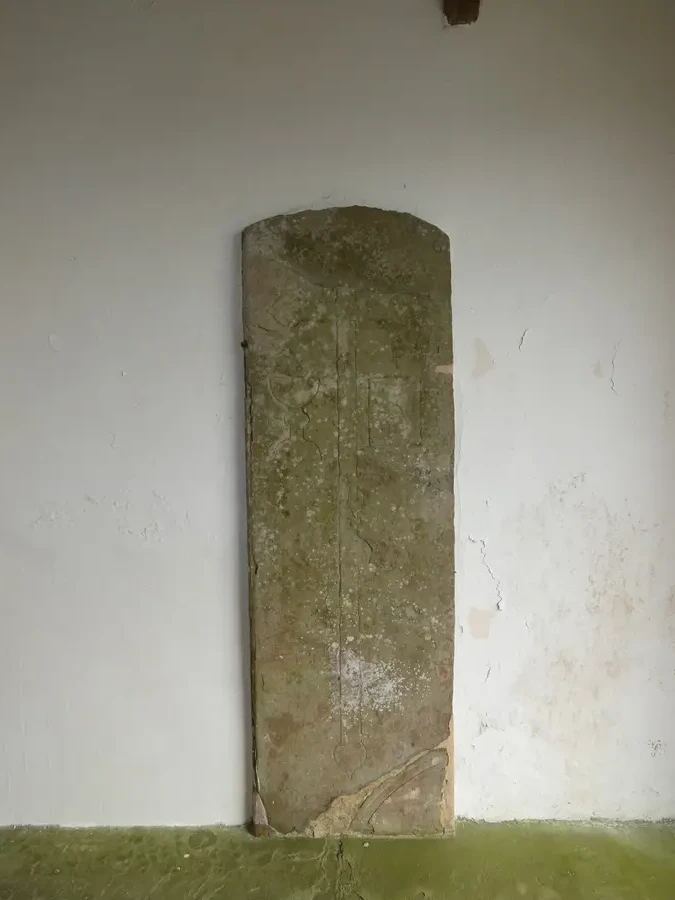 a tower. A Great Spotted Woodpecker drums, Jackdaws chack, a Great Tit sings its two note song, a Chaffinch pinks and a Ribbon sings. Next to the Rectory is the church of St Michael.
a tower. A Great Spotted Woodpecker drums, Jackdaws chack, a Great Tit sings its two note song, a Chaffinch pinks and a Ribbon sings. Next to the Rectory is the church of St Michael.
A large Yew of some considerable age stands just inside the churchyard. On the corner of the church is a strange carving in the some depicting what is believed to be a man and woman dancing, although they are shown on their sides. The many gravestones are barely legible although it is clear there are a lot of Powells, Prices, Lloyds and Joneses. The  churchyard is circular, often a sign it is possibly pre-Christian and certainly pre-Conquest in origin.
churchyard is circular, often a sign it is possibly pre-Christian and certainly pre-Conquest in origin.
The church dates from the 13th century but was extensively restored in 1877 by W Chick of Hereford. The porch is large with two gravestones, one 18th century the other a mediaeval coffin lid. The nave roof is 19th century arch-braced tie-beam trusses; chancel roof has 15th century arch-braced trusses and quatrefoil windbraces. The pointed chancel arch and furnishings including Godwin’s tiled floor are 19th century. The original south chancel door was blocked in the 18th century. There is a trefoil piscina in the chancel. Here also is a stone pillar with incised symbols including large cross with ring and dot devices and smaller crosses in the angles and undeciphered Ogham script on its edge, which is possibly pre-Christian with the symbols added later or early Christian dating to 7th to 9th centuries. The font is octagonal. There are two bells, one early 13th and one mid 16th century. An ornate key is in a box on the wall, that used for the opening of the church hall by the Archdeacon of Brecon in 1914. A harmonium with a large mirror in the backboard stands in a corner.
Sunday – Leominster – A mild morning with a slight breeze, not enough to raise the flag on the Tourist Information Centre. The sky is mainly cloud. The usual chacks come from the rooftop Jackdaws. Pigeons bill and coo here too. A passing pedestrian raises a scream of alarm from a Blackbird before it resumes its song, which has been ringing out since dawn. Onto the railway footbridge. A few gulls fly over, high on the sky. There are Jackdaws everywhere, too many! A Robin sings in the riverside woods.
Onto Butts Bridge. The water level in the River Lugg has fallen a little. A Great Tit calls upstream. A Wren sings and Blue Tits chatter. Into Pinsley Mill. A Song Thrush sings and a Great Spotted Woodpecker drums across the railway tracks. Into the Millennium Park snow drops are fading rapidly now. A pair of Magpies fly past. A Chiffchaff calls, my first of the year. Just a few daffodils are in flower. Robin song comes from every direction. The River Kenwater is little changed over the past few weeks. The Minster Bells toll 9 o’clock and this week the call to morning prayer rings out.
Into the churchyard. Grey Squirrels chase up the trees. Into Church Street. A cherry is in flower scattering pink confetti all over the road.
Home – We tidy up the rose bower – a job that always results in a scratch or three. At dawn I had gone to The Broad, a short distance up the Ludlow Road, and got a couple of bags of horse manure. This will go into the compost. Another potato trench is dug but that is enough for my back. In the evening the chicken house door closed too early for the hens to go to bed. I hook it up but a couple of hours later they are still all on the plank up to the door; it seems the door was not open enough for them. I pick up each of them and put them into the house. I will check the closing time tomorrow.
Monday – Croft – Another relatively mild morning it is very misty in the distance. A Robin and Blackbirds sing near the car park. At the top of Fishpool Valley a pair of Blue Tits are examining a hole in a tree. Tree removal has 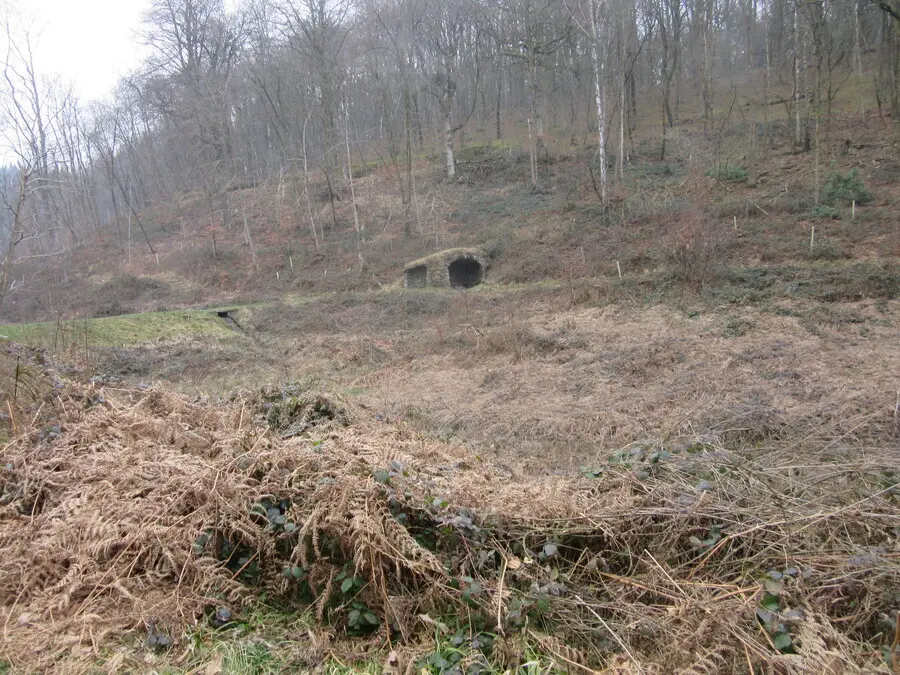 continued below with freshly sawn trunks laying on the ground. A Song Thrush sings further up the valley. The call of a Chiffchaff comes from the Beech woods across the ponds. Large numbers of trees have been felled and the plastic protectors of saplings are all over the sides and base of the valley. The pools are dark and brooding. The valley was created by glacial meltwater. A large moss covered tree had been brought down by the wind. The trunk has been cut off. A Great Spotted Woodpecker drums on a good resonating branch in the Beech wood. A pair of Mallard are on one of the top pools. The rustic shelter is now completely out in the open. More Song Thrushes, Chiffchaffs, Blue Tits, Wrens and a Dunnock are in good voice. A bank reveals crumbling layers of Lower Lientwardine Formation Siltstone laid down in the
continued below with freshly sawn trunks laying on the ground. A Song Thrush sings further up the valley. The call of a Chiffchaff comes from the Beech woods across the ponds. Large numbers of trees have been felled and the plastic protectors of saplings are all over the sides and base of the valley. The pools are dark and brooding. The valley was created by glacial meltwater. A large moss covered tree had been brought down by the wind. The trunk has been cut off. A Great Spotted Woodpecker drums on a good resonating branch in the Beech wood. A pair of Mallard are on one of the top pools. The rustic shelter is now completely out in the open. More Song Thrushes, Chiffchaffs, Blue Tits, Wrens and a Dunnock are in good voice. A bank reveals crumbling layers of Lower Lientwardine Formation Siltstone laid down in the 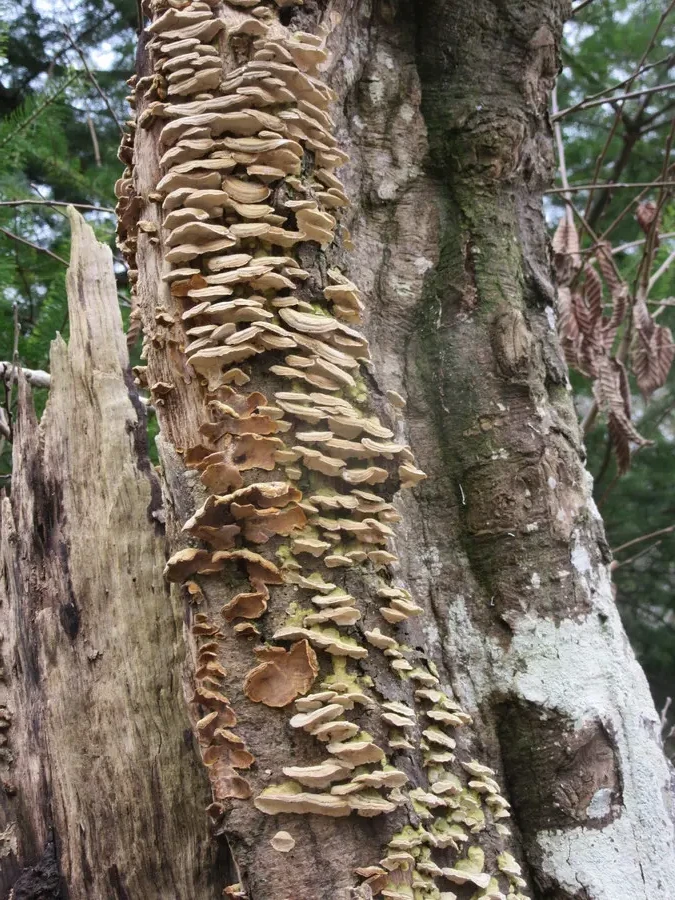 Silurian, 425-423 million years ago. Towards the end of the valley, Brambles have spread everywhere.
Silurian, 425-423 million years ago. Towards the end of the valley, Brambles have spread everywhere.
Up out of the valley. Despite the lack of rain recently, water is pouring out of the lowest of the springs on the hillside. A Common Buzzard flies across from one hillside of conifers to the other, disappearing into the darkness. Higher up, the springs are dry but water flows down the very muddy track. Primroses and Opposite-leaved Saxifrage are in flower. A Silver Birch blocks the path, so I climb the bank onto the forestry track. Leaves are appearing on Elders. The area between the track and the top of the ridge had been thinned drastically and the thick, dark conifer plantation now lies in a large pile of logs. At the top of the remains of the great Hornbeam that fell a couple of years ago are rotting slowly helped by a fine covering of Many-zoned Polypore, Coriolus versicolor, fungi.
Onto the slope up to Croft Ambrey hill fort. Another Hornbeam has been blown down. Ravens croak in the mist covering Gatley Park across the valley of Allcock’s Brook. The slope below holds Leinthall Earls Fault. The ridge here is an outcrop of Aymestry Limestone. A Ring-necked Pheasant flies off with that strange rattle of wings. The great Yew is dead although its offspring nearby are flourishing and small twigs are in leaf on its boughs. Onto the hill fort. A distant part Wigmore Lake, now fields, is lit in sunshine. To the west, a little of the hills can be discerned through the mist. To the east, 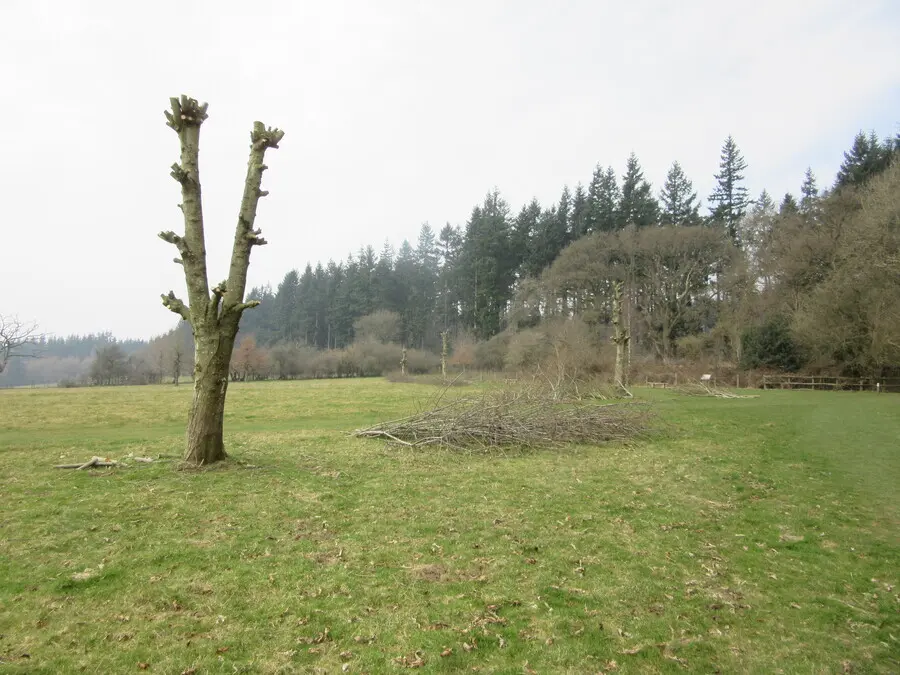 nothing, just grey. The top of the hill fort has been cleared, just a few little Hawthorns and Silver Birches.
nothing, just grey. The top of the hill fort has been cleared, just a few little Hawthorns and Silver Birches.
Down past the pillow mounds, artificial rabbit warrens built in mediaeval times. At the foot of these mounds excavations revealed a Romano-British shrine with evidence of feasting, fire ceremonies and animal sacrifices. Down the track past a number of large conifers downed by the autumn and winter storms. A Great Tit calls persistently. A Chaffinch calls. Now a Chiffchaff joins in. Am old rotting Silver Birch truck has numerous Birch Polypore, Fomitopsis betulina, fungi, also known as Razor Strop, on it.
Onto the Spanish Chestnut field. Several trees at the top of the field, possibly Ashes, have had every branch removed. A nonstop twittering comes from the trees at the top of the Fishpool Valley, across a field. They must be a large flock of Starlings, but there is no sign of them. On down the field where several Gorse bushes are covered in bright yellow flowers. A number of the replacement chestnuts have also had all their branches removed. A banner celebrates a ghost tree one of the Great old Spanish Chestnuts probably dating from the Tudor period and now just a glorious mass of dead branches. Dark chocolate sheep are beneath the apple trees in the orchard between the field and the castle farm. There is water in the quarry pond. It seems strange that is now over a decade since I used to send Maddy into this pond to wash the mud off before we got back to the car.
Friday – Leominster – There was an eclipse of the moon in the early hours of the morning. The moon is brilliant all night, lighting up the walls of the houses. However, shortly before the eclipse is due to begin, the sky starts to cloud over. Then before the eclipse really becomes visible the moon sinks behind the roof next door. I give up and get back into bed.
Aberhonddu – Brecon – Clouds sit on the tops of the hills and mountains of Bannau Brycheiniog. The morning is cool with not too much blue in the sky. I park on the edge of the town, on the site of large railway sidings, all gone including the line. Down to the canal. Over Watton Bridge. From the other side of the canal one can just make out the second arch under which ran a tramroad which had completely disappeared under modern development. Nearby is the former toll house and lime kilns. A terrace of houses had a large gable in the centre with a large bell in a roofed wooden frame. Half a dozen Mallard 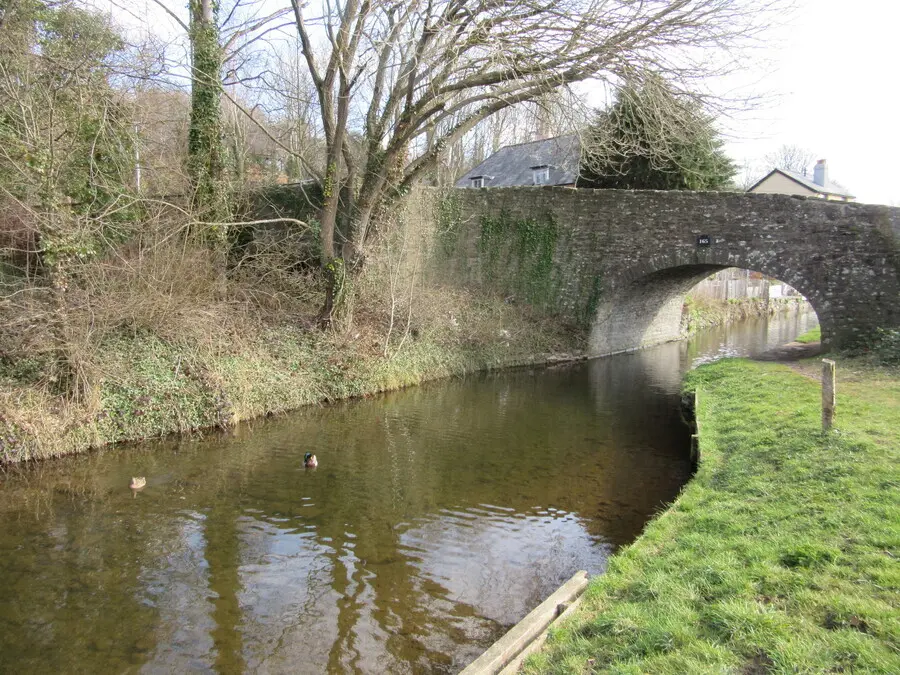 are on the water. Opposite is the remains of Watton Wharf. On towards the town. A long barn and a row of cottages, the first having a filled in arch, have all been modernised. A pair of whistling and chatting Starlings sit at the top of a Hawthorn. Traditional looking houses stand on the site of the former gas works. A cat comes down to the water for a drink watched closely by a Mallard. Beyond the tow path are some very neat allotments. Under a couple of bridges and into Brecon Basin, Fasn Aberhonddu. The basin, which only is some 35 years old, has older cottages and the former Weights and Measures Office on one side and a modern theatre, Theatr Brycheiniog, built in 1997, on the other.
are on the water. Opposite is the remains of Watton Wharf. On towards the town. A long barn and a row of cottages, the first having a filled in arch, have all been modernised. A pair of whistling and chatting Starlings sit at the top of a Hawthorn. Traditional looking houses stand on the site of the former gas works. A cat comes down to the water for a drink watched closely by a Mallard. Beyond the tow path are some very neat allotments. Under a couple of bridges and into Brecon Basin, Fasn Aberhonddu. The basin, which only is some 35 years old, has older cottages and the former Weights and Measures Office on one side and a modern theatre, Theatr Brycheiniog, built in 1997, on the other.
A road of modern shops and a supermarket leads to the main road, Watton, and into the town centre. The large former Shire Hall with an outsized portico with massive stone columns is now the museum and art gallery. The town walls ran across the road here, where the Watton Gate stood. Nearby is a former bank, now a bar and opposite a very large Georgian house, was a hotel and maybe still is but undergoing substantial refurbishment.
Up The Bulwark and into St Mary’s Parish Church. It is large building in red sandstone. The Buckingham Tower was built for military purposes and erected in 1521 by Edward Stafford, Duke of Buckingham and Marcher Lord of Brecknock. A decorated coffin lid is inside the door along with a 15th century holy water stoup. The nave and aisles are given over to a busy café. Tablets on the wall have the Lord’s Prayer, the Commandments and the Apostles Creed. A woman approaches and tells me she and others are putting together a history of the building. It was a 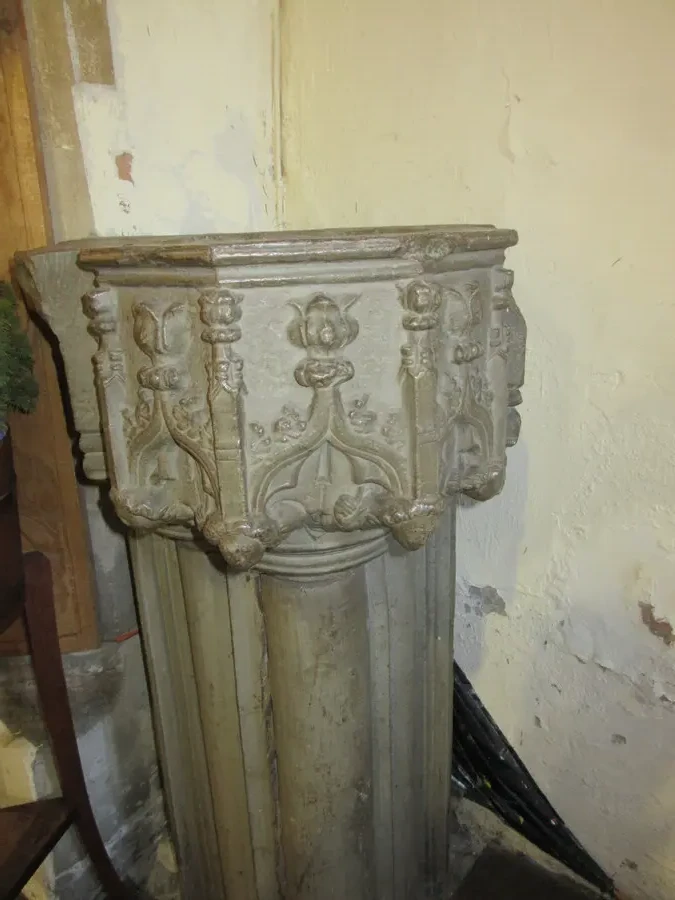 chapel of ease to the Benedictine Priory, and became the parish church only in 1923 when the Priory was elevated to cathedral status. It has 12th century origins and much is 14th century. In 1856-57, TH Wyatt carried out a restoration, raising the roof and pillars along the nave. The altar and reredos are carved wood. Above is a modern window, John Petts, 1989, of a standing figure of Christ in a mandorla, at the centre of a five-light window, surrounded by symbols in roundels. On the 15th September 1963, the Ku Klux Klan planted a bomb at the 16th Street Baptist Church in Birmingham, Alabama, killing four black girls attending Sunday school. John Petts launched a campaign to fund and create a new window as a gift to the church from the people of Wales. This is the sister window of that in Alabama.
chapel of ease to the Benedictine Priory, and became the parish church only in 1923 when the Priory was elevated to cathedral status. It has 12th century origins and much is 14th century. In 1856-57, TH Wyatt carried out a restoration, raising the roof and pillars along the nave. The altar and reredos are carved wood. Above is a modern window, John Petts, 1989, of a standing figure of Christ in a mandorla, at the centre of a five-light window, surrounded by symbols in roundels. On the 15th September 1963, the Ku Klux Klan planted a bomb at the 16th Street Baptist Church in Birmingham, Alabama, killing four black girls attending Sunday school. John Petts launched a campaign to fund and create a new window as a gift to the church from the people of Wales. This is the sister window of that in Alabama.
Behind the church in Church Street are large former early 19th century warehouses, including North House, associated with Lord North. A plaque remembers Dr Thomas Coke (1747-1814), founder of the Methodist Episcopal church of America. He was baptized in St Mary’s. Church Lane comes out onto Wheat Street opposite the Art Deco cinema, still operating as such! Down the street is the Catholic St Michael’s church and hall. It was built 1851 by Charles Hansom. The great Spanish soprano Adelina Patti, who lived at Craig-y-Nos Castle, married her third husband, Baron Cederstrom in the church in 1899. On the bend is Buckingham Place. A pair of houses are an important early to mid 16th century houses. They belonged to the Awbrey Family in the late 16th and early 17th centuries and a stone bearing the Awbrey Arms was discovered during the course of alterations above a former fireplace beneath wooden panelling. Down St Michael’s Street to Usk Terrace which overlooks the River Usk. Across the river is Christ’s College, a private school, founded by Henry VIII in 1541 on the site of St Nicholas’ Monastery. Into Market Street. Brecon Castle stands above the River Honddu which joins the Usk a short distance away. The castle is part of a hotel which is closed for refurbishment. Opposite is the back of Brecon Market. Over the river and round to The Avenue which has a fine view of the mountains.
Alleyways lead to streets of early and later 20th century terraces and then on to the cathedral. This was one of the first places we visited when we moved to The Marches. The building is empty and seems to be a rather cavernous space. I sit a while in the sun before going down Priory Hill, over the Honddu and into The Struet. Three Red Kites circle overhead. There are too many decaying houses, empty shops and closed pubs here. The market is far from bustling. Back along the Watton past the Barracks of the Borderers Regiment to the car.
Sunday – Leominster – There is a lot of blue sky and bright sunshine. However it is still rather cool. A Jackdaw is being very noisy. A feral pigeon is cooing and bobbing, trying to impress a female, who is clearly unimpressed and flies off. A Blackbird that was in full flow at dawn has departed. A Song Thrush sings behind the houses. Further on down the street, House Sparrows chirp excitedly. A pair of Goldfinches are in the large tree at the foot of the road. A Wren sings from a pollard stump by the railway. A pair of Carrion Crows watch from the trees across the track.
A thin coating of frost is on the railway bridge. Onto Butts Bridge. The water level in the River Lugg continues to fall and the water is clear enough to see the river bed now. A Chaffinch sings in the trees. Another Wren joins it. Back over the bridge and into the Millennium Orchard. A Chiffchaff calls in the hedgerow, Magpie grunts, Wood Pigeons coo, a Great Tit calls and a Song Thrush repeats every phrase of his song. Leaves are appearing on the Hawthorns. The Snowdrops have finished. For some reason the majority of the daffodils have come up blind. A few Ransoms are large enough to pick for the chickens. The Minster bells ring out. The River Kenwater runs slower and lower this week.
Into the churchyard where Robins sing. There seem to be far fewer aircraft this morning just the Los Angeles to Paris Boeing 777 flying over. Of course, it simply means I have missed others as the vapour trails are dissipating very quickly. Wild Arums, the Cuckoo Pint, are growing in profusion everywhere something I do not really remember years ago; they were around but did not seem particularly common.
Into Church Street. I peer through the windows of the still unsold Georgian house. Plaster is falling off the walls revealing brickwork in poor condition. Whoever finally purchases the property has a major refurbishment job on their hands. Bell practice starts.
Monday – Leominster – A grey, cool morning, although a little milder than the last few days. However, the dullness seems to have reduced the birds to a few squeaks and chirps. Through the town to Cranes Lane and on into the Oldfield estate. A path leads to Kenelmgaer Bridge over the River Kenwater. A chilly wind blows. Along the riverside path. Water passes noisily over one of the many weirs along this stretch. A multi-trunked Spruce has cracked at its base and what looks like five trunks have crashed down leaving another four still standing. Ransoms are growing on the river bank.
Up the hill towards Green Lane. Fencing still stands on the hillside. Planning permission was being sought to build houses here but nothing had come of it. Into The Rugg housing estate. Blackbirds search a green space for food. Along The Rugg to Green Lane then through to Bargates and down into the town centre.
Wednesday – Leominster – An early morning wander. The air is sharp, just above freezing. Scattered thin clouds are lit yellow and orange by the rising sun which is still hidden behind Eaton Hill. Blackbirds are singing lustily. Jackdaws and Wood Pigeons fly about. House Sparrows chatter. Over the railway there is a dusting of frost on the bridge. The bird song in the riverside wood is it rather muted, a distant Blackbird and a couple of Wrens. A pair of Hares are chasing across Lammas Meadow. They disappear into the corner beside Mosaic Bridge. Rabbits are along the edge of the field and scurry off into the woodland.
Onto Butts Bridge. A Grey Wagtail flies upstream. Back over the railway bridge. The Holyhead, Caergybi, train pulls in. There are few passengers. A Dunnock sings in the yard beyond the bridge. The large mound of debris from the town centre works is still there. Into Pinsley Mill. The sun has emerged from behind Eaton Hill and lights up the Leeds to Tenerife 737 in bright silver. The cars here are heavily frosted. Into the Millennium Orchard. Several trees by the entrance gate have been chopped down and a large pile of logs lay by the path. Lesser Celandines flower in the grass.
A dead Wood Pigeon lays by the south east entrance to the churchyard; it does not look as though it has been eaten although some breast feathers have been removed. Maybe a Peregrine or similar has downed it but been scared off. The downed Silver Birch seems to be being cut up a bit at a time. A Great Tit calls its squeaky bicycle wheel song. A Lesser Black-backed Gull walks along the ridge of the church roof. Onto the Grange. A Wren hammers out its staccato alarm call from one of the evergreens by Grange Court. Vapour trails slowly widen in the sky before dissipating.
Home – A Chiffchaff calls from nearby gardens. Primroses are in flower everywhere. Some are a purple-pink colour, not sown by us. Seedlings of lettuce, purple sprouting and broad beans are all coming on in the greenhouse. In the afternoon, a Brimstone butterfly speeds past. Large Bumble Bees also are travelling around the garden at a rate.
Thursday – Cromford – A couple of days with The Buglers in Bradford. We are stopping overnight in Matlock Bath. First we stop in Cromford, a small Derbyshire village a few miles to the south of Matlock. There is a weird reason 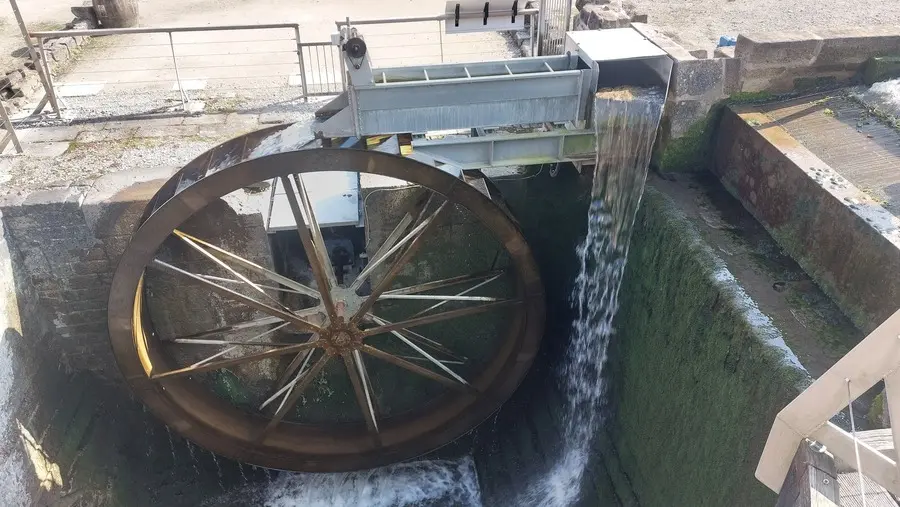 for stopping here. A television programme relating a murder here with the body being found at the railway station. The station had an interesting building next to it. It is said to have been designed by G. H. Stokes, son-in-law of Joseph Paxton. It is believed that Stokes designed Station House, built in 1855, the extremely ornate former station master’s residence opposite the station on the side of the hill as well as the ornate villa style waiting room, on what was the up platform. Also here
for stopping here. A television programme relating a murder here with the body being found at the railway station. The station had an interesting building next to it. It is said to have been designed by G. H. Stokes, son-in-law of Joseph Paxton. It is believed that Stokes designed Station House, built in 1855, the extremely ornate former station master’s residence opposite the station on the side of the hill as well as the ornate villa style waiting room, on what was the up platform. Also here  are Cromford Mills, world’s first water-powered cotton spinning mill, developed by Richard Arkwright in 1771. A waterwheel had been reconstructed and running, providing electricity. There are a number of small businesses here: antiques, arts materials, cheese shop and a visitor centre. Nearby is St Mary’s church, originally planned as a chapel for Willersley Castle, Which is high on the side of the hills across the river, by Sir Richard Arkwright and was completed five years after his death in 1797. Unfortunately it is locked. Back to the village which lies on the A6 which is extremely busy. A row of shops in The Market Place date from the late 18th century. Here also is The Greyhound Hotel, a large, three storey building from the mid 18th century. Up Scarthin. The War Memorial was unveiled on 5th September 1920 by JH Toplis, a local man who had served throughout the First World War; as a Private in the Sherwood Foresters during the Gallipoli campaign, and on the Western Front in the Lincolnshire Regiment. Opposite is a fine bookshop and café. Past a former Primitive Methodist chapel, closed in 1920, and down the hill again. The area below is occupied by a large millpond. On the far side is another closed Methodist chapel, this one built in 1900. The road to Wirksworth, called The Hill, is lined with late 18th and 19th century houses and former shops.
are Cromford Mills, world’s first water-powered cotton spinning mill, developed by Richard Arkwright in 1771. A waterwheel had been reconstructed and running, providing electricity. There are a number of small businesses here: antiques, arts materials, cheese shop and a visitor centre. Nearby is St Mary’s church, originally planned as a chapel for Willersley Castle, Which is high on the side of the hills across the river, by Sir Richard Arkwright and was completed five years after his death in 1797. Unfortunately it is locked. Back to the village which lies on the A6 which is extremely busy. A row of shops in The Market Place date from the late 18th century. Here also is The Greyhound Hotel, a large, three storey building from the mid 18th century. Up Scarthin. The War Memorial was unveiled on 5th September 1920 by JH Toplis, a local man who had served throughout the First World War; as a Private in the Sherwood Foresters during the Gallipoli campaign, and on the Western Front in the Lincolnshire Regiment. Opposite is a fine bookshop and café. Past a former Primitive Methodist chapel, closed in 1920, and down the hill again. The area below is occupied by a large millpond. On the far side is another closed Methodist chapel, this one built in 1900. The road to Wirksworth, called The Hill, is lined with late 18th and 19th century houses and former shops.
Matlock Bath – We had not not researched this small former spa in a deep valley of the River Derwent. Many call it “Blackpool without the sea”. There are hundreds of motorbikes in the main street. The shops are very much of a seaside vibe, seven fish and chips shops, sweet shops, amusement arcades and pubs. The majority of the buildings are Regency in origin. The Grand Pavilion, built in 1910 by John Nuttall, now houses the Mining Museum. High above the valley are the Heights of Abraham and Heights of Isaac. A cable car runs up to the former.
Friday – Matlock – A larger former spa town lying on the River Derwent. The area was a collection of small villages until thermal springs were discovered in 1698. The population increased rapidly in the 1800s, largely because of the popular hydros that were being built. At one stage there were around twenty hydros, mostly on Matlock Bank, the largest built in 1853 by John Smedley. The name Matlock derives from the Old English mæthel (or mæðel), meaning assembly or speech, and āc, meaning oak tree; thus Matlock means “moot-oak”, an oak tree where meetings are held. It is recorded in the Domesday Book recorded as Meslach and in 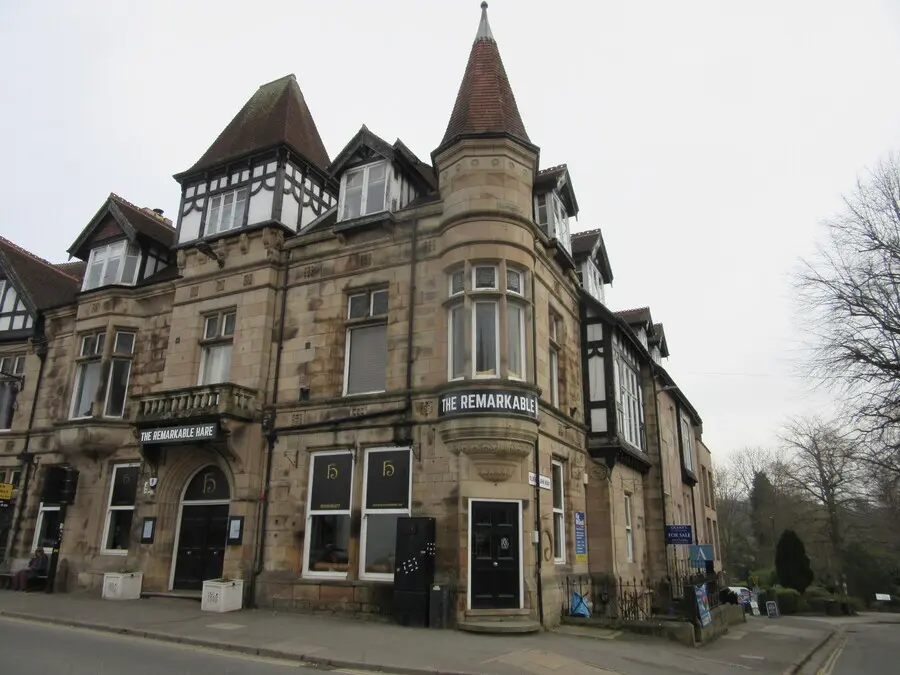 1196 it was named Matlack.
1196 it was named Matlack.
We walk along the Bakewell Road to towards the town centre. Up Bank Road. Large late Victorian buildings, including Crown Buildings and the Crown Hotel stand at the foot of the hill. The early 20th century Post Office is at the top end of a row of shops. Derbyshire Dales District 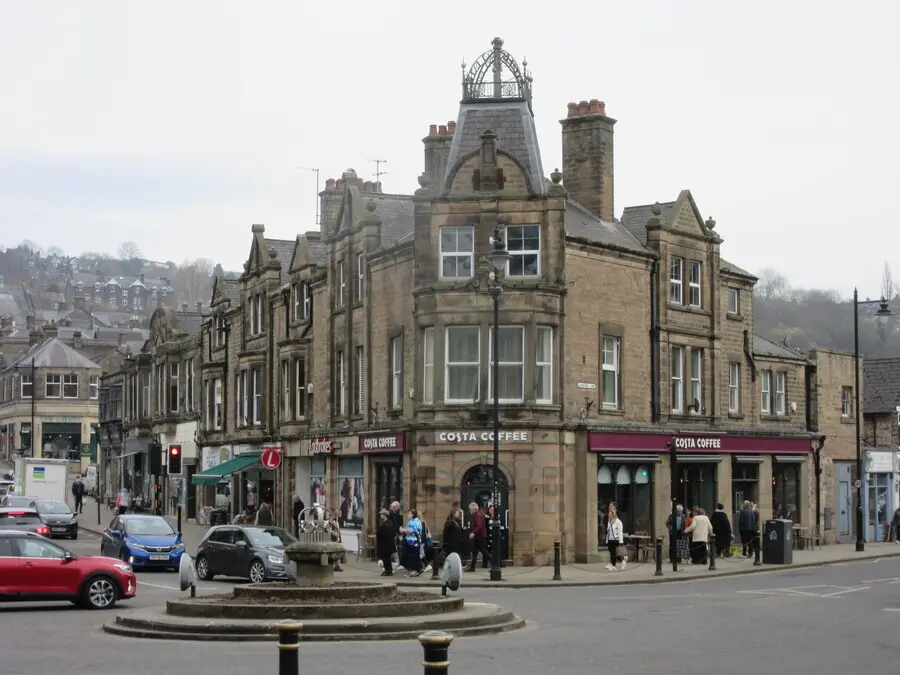 Council Offices are in a large building, formerly Bridge Hall, then a hydro called Bridge House, established by 1861. In 1894 the Matlock Urban District Council bought Bridge House hydro for use as the Town Hall and added a large wing in the Italianate style. Back down to the foot of Matlock Bridge. A rookery is in nearby trees. Beneath them and across to the river is a formal garden.
Council Offices are in a large building, formerly Bridge Hall, then a hydro called Bridge House, established by 1861. In 1894 the Matlock Urban District Council bought Bridge House hydro for use as the Town Hall and added a large wing in the Italianate style. Back down to the foot of Matlock Bridge. A rookery is in nearby trees. Beneath them and across to the river is a formal garden.
On to Matlock Bridge. The downstream side of the bridge dates from the 1400s. The bridge was widened in 1904. Two drake Mallard are fighting, drifting under the bridge then over the rocks and down the river still flapping and chasing each other with some violence. Eventually one moves off and both sit on the water looking as if honour has been satisfied. They then fly off upstream. On the far side is a large empty building: Bank House, formerly William Deacons Bank, then Derbyshire Stone Co Offices. Dale Road is lined with independent businesses.
Bradford – We are staying at the Great Victoria Hotel built in 1867 by Lockwood and Mawson. It is a large sandstone building in the Italian Romanesque detailing to the fenestration but with a French pavilion, a slightly domed roof, over the short flanking wing. The route to the hotel is blocked by roadworks and the detour route is utterly confusing, however we get there. That called for a pint and a curry.
Saturday – Bradford – We go to Little Germany. The area was developed by German Jews in the textile businesses. Many buildings are four or more storeys high in grey-brown stone. The architectural practices involved included Milnes & France, Lockwood & Mawson, Andrews & Delaunay and J.T. Fairbank building in the Italianate style. One building in particular is the 1871 building by George Corson for Scottish clients is in Scottish baronial style. There is however, am unfortunate modern extension built on top. Another,  Caspian House (61 East Parade) was built in 1873, as the warehouse of D. Delius and Company; the senior partner in the business was the father of the composer Frederick Delius. In Chapel Street is an armchair and a grandfather clock in stone created by Timothy Shutter, these pieces of stone furniture are a sculpture by the name of
Caspian House (61 East Parade) was built in 1873, as the warehouse of D. Delius and Company; the senior partner in the business was the father of the composer Frederick Delius. In Chapel Street is an armchair and a grandfather clock in stone created by Timothy Shutter, these pieces of stone furniture are a sculpture by the name of 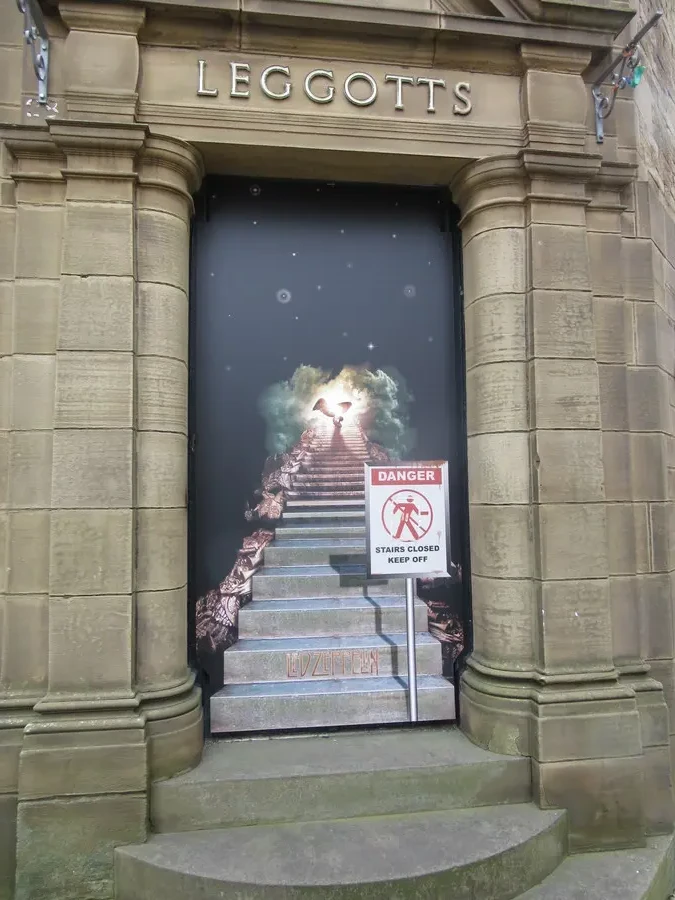 Grandad’s Clock and Chair. The piece was commissioned in 1991 by Bradford Council and Little Germany Action Group, and installed in 1992. Shutter created a bit of a mill owner’s office out of sandstone, with a chair, mirror, and grandfather clock. A modern building has two fine etched glass windows. A number of empty buildings with blocked entrance doorways have amusing murals.
Grandad’s Clock and Chair. The piece was commissioned in 1991 by Bradford Council and Little Germany Action Group, and installed in 1992. Shutter created a bit of a mill owner’s office out of sandstone, with a chair, mirror, and grandfather clock. A modern building has two fine etched glass windows. A number of empty buildings with blocked entrance doorways have amusing murals.
We moved on to the Bradford Cathedral. Formally Bradford Parish Church which has stood on the hillside above the “broad ford” that gave Bradford its name. It is likely that Christianity reached this site as a result of Bishop Paulinus’s mission from the court of King Edwin of Northumbria, between 627-633. Paulinus visited Dewsbury, where a Christian community was established, and from there a mission was sent out to Bradford-Dale. In early times, the parish of Bradford belonged to the Saxon parish of Dewsbury. It is believed that at some time a small wooden or wattle church would have been erected, with a preaching cross outside. Two fragments of carved stone crosses, dating from Anglo-Saxon times, were excavated during rebuilding work in the nineteenth century. Domesday Book records Bradford, “Ilbert hath it. It is waste”. At the time of the Domesday survey, Bradford was part of the parish of Dewsbury and Ilbert de Lacy, who came over with William the Conqueror, was the Norman lord of the manor. It is said that Eldred Beaney restored the church in 1096. This may have been because of fighting and unrest that occurred in the area, as a result of the Conquest.
A stone church, about half the size of the present nave, was built around 1200. A market charter was granted in 1251 to allow the holding of medieval weekly markets on a Sunday, in order to encourage attendance at worship. Around 1327, Scottish raiders burnt down most of this stone church, leaving only the four pillars now standing on the south side, nearest the chancel. Further physical evidence of this church and its fate was unearthed when fire-blackened stones and the foundations of an earlier building were found during the mid 20th century extension work. The rebuilding work, which created the present church, began in the late 14th century, having been delayed by war, famine and plague. Early work included two proprietary chapels for the Leventhorpe and Bolling families, and the nave arcades. The rebuilding was largely completed by 1458, with the addition of the tower in 1508, for which it is believed Sir Richard Tempest was largely responsible. The stone came from a nearby quarry, and a steep old cart track leading to this was uncovered when foundations were being laid for the Song Room at the west end in 1951. During the Civil War sieges of Bradford in 1642 and 1643, Royalist forces attacked the town, which had fewer than 3,000 inhabitants. In July 1643, after Sir Thomas Fairfax retreated from the battle of Adwalton Moor, the church tower came under threat from Royalist cannon fire and was hung with woolsacks for protection, an event known as the Battle of the Steeple. Cannonballs have since been unearthed at the foot of the tower. The woolsack on the Cathedral coat of arms is a reminder that the church was saved from destruction in this way during the Civil War. The cathedral has a mix of Victorian and 20th century glass. The Victorian glass is led by the 1860s work of Morris & Co. along with renowned artists such as Dante Gabriel Rossetti, Edward Burne-Jones, Ford Madox Brown, Philip Webb, Albert Moore, and Peter Paul Marshall It is no longer in its original position, having been reset in the 1960s following the rebuilding of the Lady Chapel. The main 20th century work is a memorial of 1921 to the 6th Battalion the West Yorkshire Regiment in Arts & Crafts idiom by A. J. Davies.
Back through Little Germany to find a liquid lunch. However, Bradford City are playing at home (they won 4-1 against Colchester) so the city centre pubs are very crowded, but we find one a short distance further on. Then off for another curry at The Karachi Club, far better than the night before.
Friday – Home – It has been a week spent doing “stuff” in the garden. A piece of 4x1 wood that runs along the top of the front of the summerhouse and holds the roofing material in place has rotted away. So a new length is bought and treated with wood preservative and fixed into place. The vegetable beds are prepared for the new season. One has been dug into trenches over the past few weeks and is now ready for the seed potatoes. The other three are weeded and one has home-made compost tipped on and raked in as a top dressing. This will be the salad bed this year.
In the greenhouse, lettuces and purple sprouting are coming along. Broad beans are taken out to the cold frame and will go into the main bed shortly, after it has also been top dressed. Kay has made up two troughs of strawberries and these are placed where they will get plenty of sun. A tray of sliver chard are sown along with thirty plugs of beetroot. In the bathroom, the tomato seedlings have been pricked out and potted on. Aubergines are doing very well but chillies seem a little slow. Some sweet peppers are sown and go here in the warm.
Primroses, daffodils and Snake-head Fritillaries are in flower in the meadow patch. Lots of Pulmonaria are in flower and they are attracting a good number of bees. Small Tortoiseshell and Brimstone butterflies are visiting the garden regularly. A Chiffchaff calls all day. A Blackbird is still in song before dawn and a Song Thrush takes over as it grow light. Buds are opening on the fruit trees and the great Horse Chestnut.
Sunday – Leominster – Bright sunshine and a blue sky. A light wind keeps the temperature down. The clocks have gone forward, so dawn appears later and the Blackbird in the street is still in full song. Lesser Black-backed Gulls are flying over regularly. Further down the street a Great Tit calls. Jackdaws fly to and fro. On to Butts Bridge. The water level in the River Lugg 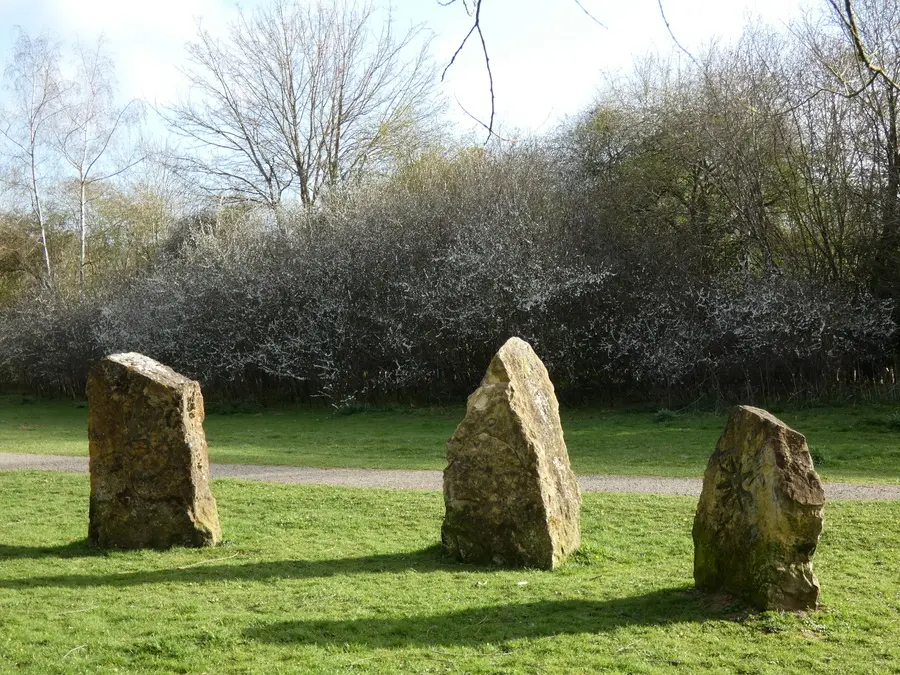 has fallen a good deal. A pair of Goosander are upstream from the bridge.
has fallen a good deal. A pair of Goosander are upstream from the bridge.
Back round to Pinsley Mill. A Chiffchaff calls from across the railway tracks. Into the Millennium Orchard. Leaves are appearing on most of the dessert apple trees and a few are opening on the Tom Putt cider tree. Blackbirds, Blue Tits, Chiffchaff, a Dunnock and a Robin sing. Blackthorn is in blossom. The ground is carpeted by Lesser Celandine, most of the flowers still closed. The sun is warm and small insects floating the air. Flower buds have appeared on Elders. Into the Peace Garden where a Song Thrush searches for food. The water level in the River Kenwater has fallen further.
Into the churchyard where a tall conifer creaks in the wind. Through to Church Street. The local florist is making Mothers’ Day deliveries.
Home – Yesterday the broad beans from the cold frame are planted into the main bed. A short row of peas, Bijou, are sown. This morning the potatoes are planted, Red Duke of Yorks, developed in 1942 and Sharpe’s Express from 1900, developed by Charles Sharpe of Sleaford. There are still large clumps of clay soil and river worn pebbles in the bed, despite the cultivation over more than a decade! A tray of spinach is sown. A Comma butterfly suns itself on the cold frame.
Monday – Leominster – Another sunny day with just a light, cooling breeze. High feathers of cirrus clouds drift almost imperceptibly eastwards. Across the railway at Pinsley Mill, a Chiffchaff calls and a Dunnock sings. Above Jackdaws find enough breeze to sail around swirling in circles. A pair of yelping seagulls also circle through the air as they chase one another. A large Goat Willow with more than a dozen trunks is pale yellow with fluffy catkins. Dandelions growing out of a crack between a wall and the tarmac are like brilliant yellow suns but luxuriating in the real thing. Hairy Bittercress is growing nearby in the same inhospitable conditions. Into the orchard. The Lesser Celandines flowers, which were closed yesterday, today are all open and facing the sun. Into the churchyard. A White Comfrey is in flower. A Robin sings.